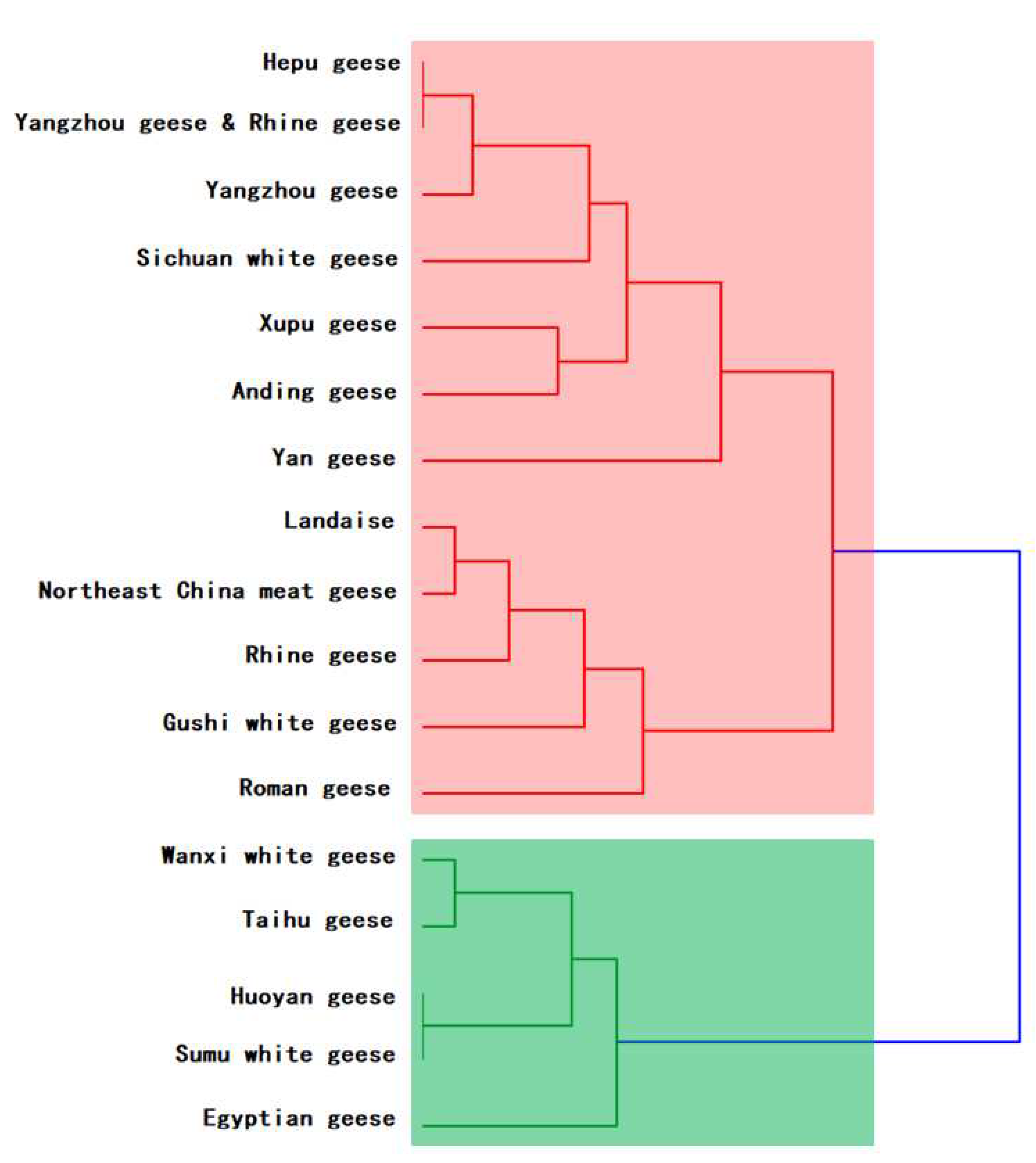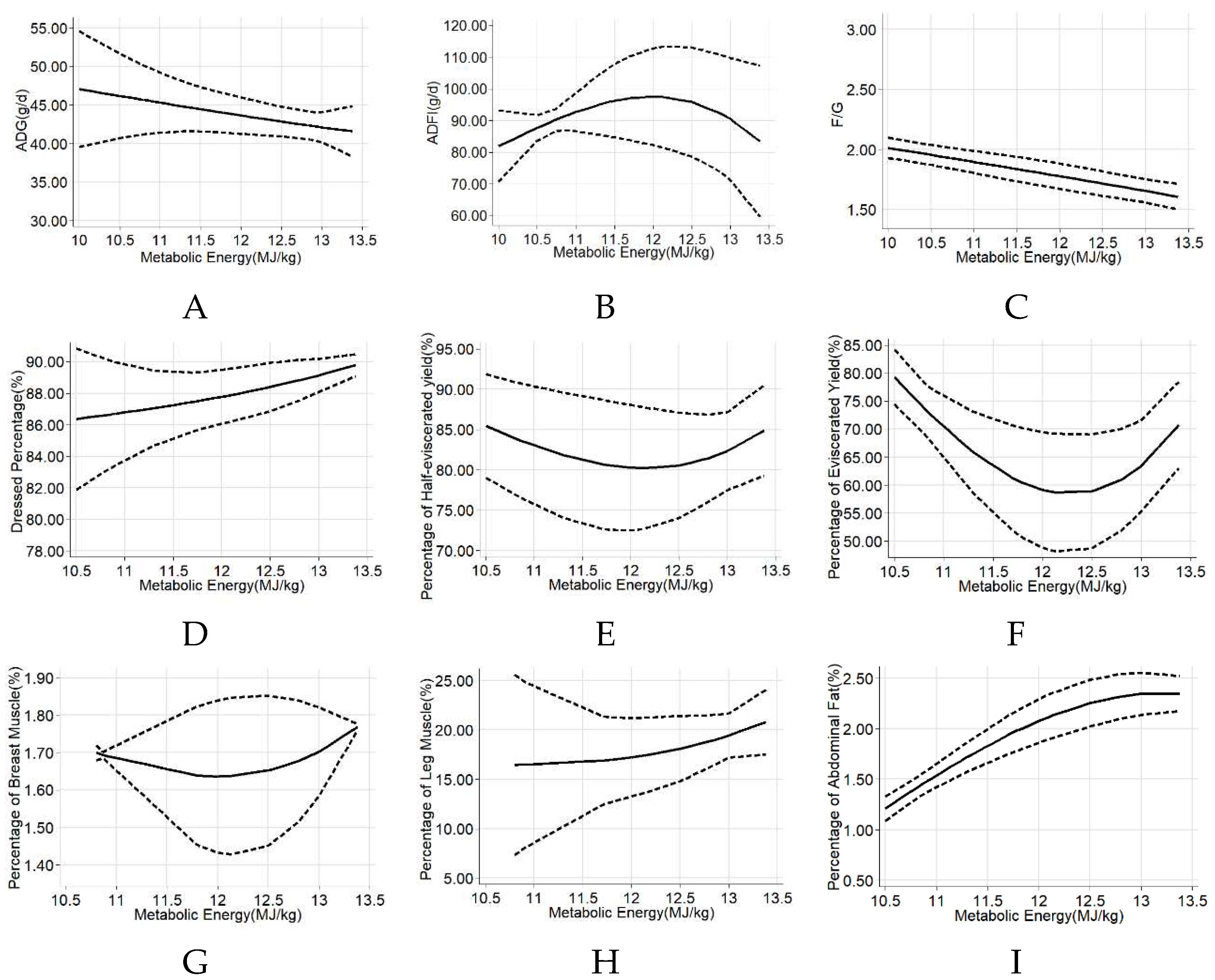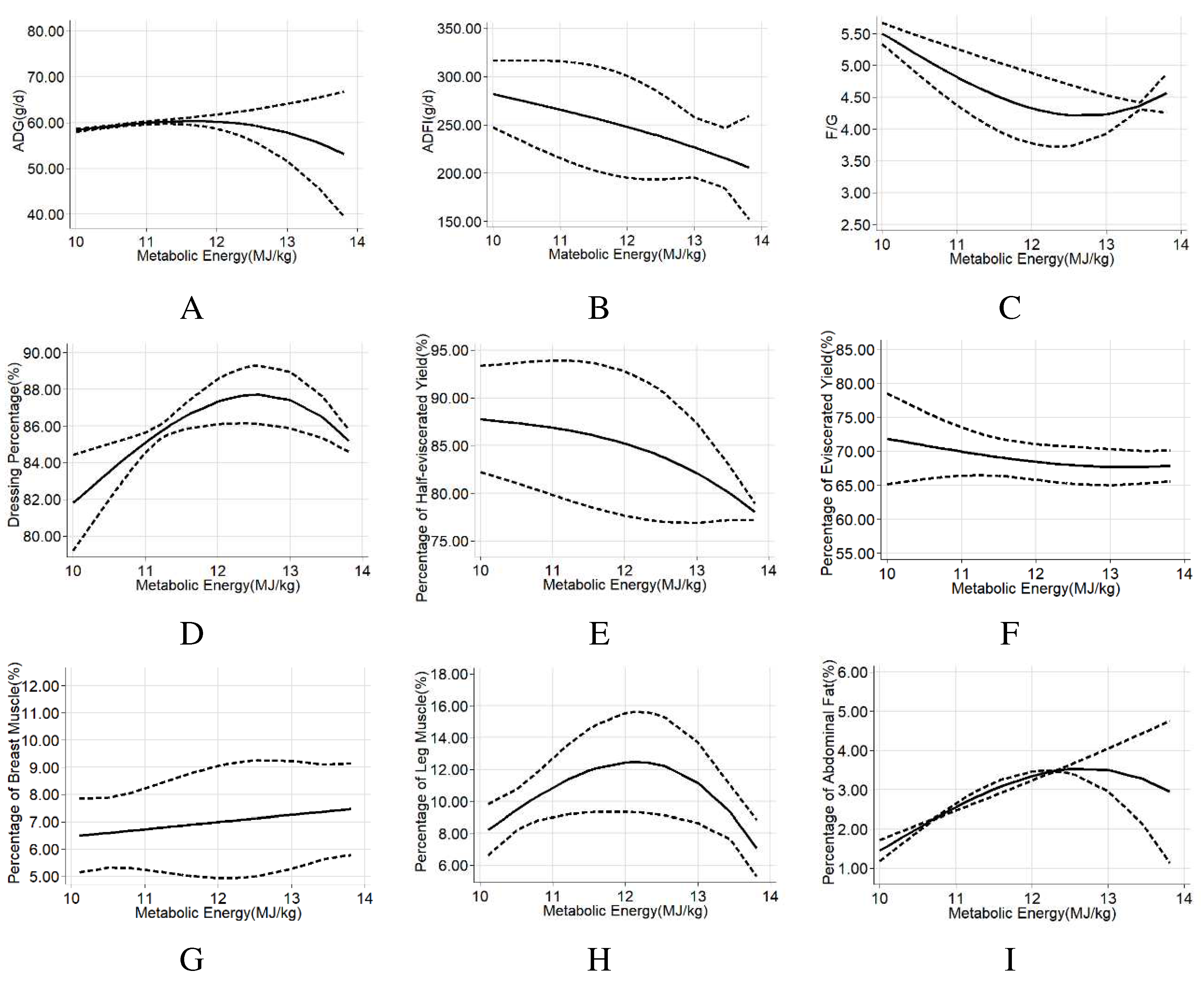Submitted:
12 September 2023
Posted:
13 September 2023
You are already at the latest version
Abstract
Keywords:
1. Introduction
2. Materials and Methods
2.1. Retrieval Strategy
2.2. Inclusion and Exclusion Criteria
2.3. Information and Data Extraction
2.4. Statistical Method
3. Results
3.1. Result of Information Retrieval
3.2. Data Treating
3.3. Results of Dose-Response Meta-Analysis
3.3.1. Medium-Sized Geese
3.3.2. small-Sized Geese
4. Discussion
4.1. Effects of Dietary Metabolizable Energy Level on Growth Performance of Geese
4.2. Effects of Dietary Metabolizable Energy Level on Slaughter Performance of Geese
4.3. Boundedness
5. Conclusions
Author Contributions
Funding
Institutional Review Board Statement
Informed Consent Statement
Data Availability Statement
Conflicts of Interest
References
- Wang, Z. Comparison of Production Performance and Evaluation of Feeding Benefit of YANGZHOU Geese under Different Feeding Modes. Master’s Thesis, Yangzhou University, Yangzhou, China, 2022. [Google Scholar] [CrossRef]
- Hou, S.S.; Liu, L.Z. Status quo, future development trend, and suggestions for the waterfowl industry in 2021. Chin. J. Anim. Sci. 2022, 58, 227–231+238. [Google Scholar] [CrossRef]
- Kucharska-Gaca Joanna, Adamski Marek, Biesek Jakub. The age of the geese from the parent flock and the laying period affect the features of the eggs. Poult. Sci. 2022, 101, 102094. [Google Scholar] [CrossRef]
- Hou, S.S. Difficulties faced by the development of China’s goose industry and suggestions on technical measures. Waterfowl World 2011, 7–10. [Google Scholar]
- Hou, J.P. Effects of dietary energy on growth performance and gene expression of muscle inhibitory factor (MSTN) in Landaise geese and Xupu geese. Doctor’s Thesis, Huazhong Agricultural University, Hubei, China, 2008. Doctor’s Thesis, Huazhong Agricultural University, Hubei, China, 2008. [Google Scholar]
- Yang, F. Animal Nutrition; China Agriculture Press: Beijing, China, 2004; p. 56. [Google Scholar]
- Zhang, C.L.; Liu, F.Z.; Hou, S.S. Effects of different energy and protein levels on production performance of meat geese during the brooding period. China Feed 2004, 24–25. [Google Scholar] [CrossRef]
- Ye, B.G.; Liu, Q.W.; Lin, D.J.; Xing, M.P.; Zhang, X. Effect of dietary energy level on growth performance of fattening Dingan geese. Poult. Rais. Dis. Control 2014, 6, 5–7. [Google Scholar]
- Stevenson M, H. Effects of diets of varying energy concentrations on the growth and carcass composition of geese. Br. Poult. Sci. 1985, 26, 493–504. [Google Scholar] [CrossRef]
- Cheng, H.N. Study on optimal levels of energy, crude protein, calcium and phosphorus in diets of Hepu geese. Master’s Thesis, Guangxi University, Nanning, China, 2005. [Google Scholar]
- Ma, Y.Q.; Yang, J.H.; Xia, Z.S.; Liao, Y.Y.; Mai, W.H.; Zhou, H. Effects of different diets on performance and nutrient metabolism of Guangxi Hepu geese. Chin. J. Anim. Nutr. 2006, 192–196. [Google Scholar] [CrossRef]
- Xu, B.C.; Zhu, L.Y.; Fu, J.; Li, Z.; Wang, Y.Z.; Jin, M.L. Overall assessment of fermented feed for pigs: A series of meta-analysis. J. Anim. Sci. 2019, 97, 125–126. [Google Scholar] [CrossRef]
- Wan, X.; Wang, W.Q.; Liu, J.M.; Tong, T.J. Estimating the sample mean and standard deviation from the sample size, median, range, and/or interquartile range. BMC Med. Res. Methodol. 2014, 14, 135. [Google Scholar] [CrossRef]
- Chen, G.H.; Wang, K.H.; Wang, J.Y.; Ding, C.; Yang, N. Poultry Genetic Resources in China; Shanghai Scientific and Technical Publishers: Shanghai, China, 2004; p. 46. [Google Scholar]
- Zhang, H.F. United States NRC Nutritional Requirements for Poultry (1994 edition). China Feed 1995, 3, 35–37. [Google Scholar]
- Xu, C.; Suhail A R Doi. The robust error meta-regression method for dose-response meta-analysis. Int. J. Evid. -Based Healthc. 2017, 16, 138–144. [Google Scholar] [CrossRef]
- Xu, C.; Liu, Y.; Jia, P.L.; Li, L.; Liu, T.Z.; Cheng, L.L.; Deng, K.; A. S.M. Borhan; Lehana Thabane; Sun, X. The methodological quality of dose-response meta-analyses needed substantial improvement: A cross-sectional survey and proposed recommendations. J. Clin. Epidemiol. 2019, 107, 1–11. [Google Scholar] [CrossRef]
- Yang, J.H.; He, R.C.; Lu, Y.F.; Mai, W.H.; Liang, F.F. Effects of different metabolizable energy and crude protein levels on dietary nutrient digestibility and growth performance of Hepu geese. Chin. J. Anim. Nutr. 2009, 21, 468–473. [Google Scholar] [CrossRef]
- Liao, Y.Y.; Yang, J.H.; He, R.C.; Qin, L.M.; Mai, W.H.; Lu, G.Q. Effects of dietary metabolizable energy level on growth performance, nutrient utilization and meat quality of geese. Cereal Feed Ind. 2006, 38–39+41. [Google Scholar] [CrossRef]
- Gu, W.J.; Zhou, G.L.; Wang, W.H.; Zhang, W.; Zhao, Q.Q.; Zhang, L. Effects of dietary metabolizable energy and crude fiber levels on slaughter performance of goslings. Anhui Agric. Sci. 2022, 50, 67–70. [Google Scholar]
- Zhang, S.J.; Zhu, C.H.; Song, W.T.; Xu, W.J.; Tao, Z.Y.; Liu, H.X.; Li, H.F. Study on nutrient requirements of energy, protein and crude fiber of Yangzhou geese. Poult. Sci. 2018, 40, 26–30. [Google Scholar]
- Li, Q.; Zhao, X.Z.; Liu, W.H.; He, D.C.; Peng, X.W. Effects of dietary metabolizable energy level on growth performance and serum biochemical indices of Sichuan White geese aged 1 to 3 weeks. Chin. J. Anim. Nutr. 2016, 28, 3076–3083. [Google Scholar] [CrossRef]
- Li, Q.; Chen, M.J.; Peng, X.W. Effects of dietary crude protein and metabolizable energy levels on growth performance and nitrogen and energy balance of Sichuan White geese aged 1 to 3 weeks. Chin. J. Anim. Nutr. 2014, 26, 2582–2589. [Google Scholar] [CrossRef]
- Cao, A.Q. Effects of dietary energy level on performance and some serum parameters of Landaise geese and Xupu geese. Master’s Thesis, Huazhong Agricultural University, Hubei, China, 2007. [Google Scholar]
- Ye, B.G.; Xing, M.P.; Gu, L.H.; Cao, Z.X.; Yang, S.X.; Liu, H.L.; Lin, D.J.; Liu, Q.W. Effects of dietary metabolizable energy on growth performance and serum biochemical indices of Dingan geese aged 1 to 4 weeks. China Poult. 2018, 40, 25–28. [Google Scholar] [CrossRef]
- Sun, Y.L.; Wang, Y.; Yuan, P.C.; Yang, G.X.; Ge, H.Z.; Xie, H.F. Effects of different energy and protein levels on growth performance of Sichuan White geese aged 0 to 4 weeks. China Poult. 2014, 36, 50–52. [Google Scholar] [CrossRef]
- Mo, Z.L.; Pan, H.P.; Luo, S.Q.; Nong, Y. Study on crude protein, crude fiber and metabolizable energy requirements of geese aged from 1 week to 5 weeks. Guangxi J. Anim. Husb. Vet. Med. 2013, 29, 325–327. [Google Scholar] [CrossRef]
- Zhao, A.Y. Study on nutrient requirements of energy, protein, and calcium in Landaise geese. Master’s Thesis, Huazhong Agricultural University, Hubei, China, 2004. [Google Scholar]
- Wang, Z.W.; Yang, G.W.; Li, J.K.; Mou, X.L.; Cao, X.Q.; Sui, M.X.; Yang, F.; Liu, D.S. Study on optimal dietary metabolizable energy, crude protein, calcium and non-phytic phosphorus levels of Northeast Meat geese aged from 1 to 28 days. Chin. J. Anim. Nutr. 2009, 21, 173–179. [Google Scholar]
- Mou, X.L.; Wang, Z.W.; Sui, M.X.; Yang, Z.W.; Liu, H.X.; Yang, G.W.; Li, J.K.; Liu, D.S. Effects of dietary nutrient levels on growth performance and blood biochemical indices of Northeast Meat geese (29~56 days of age). J. Nucl. Agric. Sci. 2009, 23, 898–903. [Google Scholar]
- Wei, Z.Y.; Zhang, J.Z.; Yu, L.H.; Wang, H.R.; Wang, M.Z. Effects of dietary energy level on performance and fat deposition of 6-10 week-old Yangzhou geese. Chin. J. Anim. Nutr. 2009, 21, 659–664. [Google Scholar] [CrossRef]
- Yin, H.C. Study on the dietary energy protein level of Gushi White geese during the growing period. Contemp. Anim. Husb. 2006, 24–26. [Google Scholar]
- Yu, L.H.; Wang, M.Z.; Wang, H.R.; Wei, Z.Y. Effects of metabolizable energy level on weight gain efficiency and body fat deposition of 6-10 week-old Yangzhou geese. Chin. J. Anim. Sci. 2010, 46, 28–32. [Google Scholar]
- Wei, Z.Y.; Wang, H.R.; Zhang, J.Z.; Yang, L.D. Effects of different energy levels on production performance and slaughter performance of Yangzhou geese. Shanghai J. Anim. Husb. Vet. Med. 2009, 27–28. [Google Scholar]
- Wu, S.L. Effects of different energy protein levels on performance and nutrient metabolism of 5 to 8-week-old female Roman geese and Wanxi White geese. Master’s Thesis, Yangzhou University, Yangzhou, China, 2015. [Google Scholar]
- Shi, S.R.; Wang, Z.Y.; Yang, H.M.; Zhang, J. Effects of dietary energy and protein levels on performance of young geese aged 5 to 10 weeks. China Feed Ind. 2006, 39–42. [Google Scholar] [CrossRef]
- Mou, X.L.; Wang, Z.W.; Yang, G.W.; Li, J.K.; Liu, D.S. Effects of dietary metabolizable energy and crude protein levels on growth performance and carcass quality of Northeast China Meat geese aged from 5 to 8 weeks. China Feed Ind. 2009, 30, 10–13. [Google Scholar] [CrossRef]
- Zhang, S.J.; Song, C.; Tang, Q.P.; Hu, Y.; Li, H.F.; Zou, J.M. Effects of different levels of metabolizable energy, crude protein, and crude fiber on growth performance and slaughter performance of Taihu geese. China Poult. 2015, 37, 27–32. [Google Scholar] [CrossRef]
- Wang, Q.F.; Chen, S.C.; Qiao, Y.L.; Zhao, X.P.; Zuo, C.; Xu, Y.Q.; Luo, H. Study on energy and crude protein requirements of 1-4-week-old Zhijin White geese. China Poult. 2017, 39, 60–63. [Google Scholar] [CrossRef]
- Min, Y.N. Study on energy and protein nutrient requirements of 0-8w meat geese. Master’s Thesis, Northeast Agriculture & Forestry University, Shaanxi, China, 2005. [Google Scholar]
- Zhang, L.; Zhou, G.L.; Duan, X.J.; Xu, S.W.; Li, F.R.; Bian, Y.Q. Effects of dietary metabolizable energy and crude fiber levels on performance and serum biochemical indices of meat geese aged 0 to 4 weeks. Chin. J. Vet. Sci. 2015, 35, 1187–1192. [Google Scholar] [CrossRef]
- Luo, H.; Chen, S.C.; Qiao, Y.L.; Zhao, X.P.; Zuo, C.; Xu, Y.Q.; Wang, Q.F. Study on energy and crude protein requirements of Zhijin White geese aged from 5 to 10 weeks. China Feed Ind. 2016, 37, 43–46. [Google Scholar] [CrossRef]
- Mahmoud, A.; Ashour Elwy, A.; El-Kholy Mohamed, S.; Abou-Kassem Diaa, E.; Tamer, R.; Abd El-Hack Mohamed, E. Consequences of varying dietary crude protein and metabolizable energy levels on growth performance, carcass characteristics and biochemical parameters of growing geese. Anim. Biotechnol. 2020, 33, 638–646. [Google Scholar] [CrossRef]
- Fan, W.X. Study on the effect of dietary energy level on fat metabolism of Xupu geese before overfeeding. Master’s Thesis, Huazhong Agricultural University, Hubei, China, 2007. [Google Scholar]
- Wu, C. Effects of dietary fiber on fat metabolism and LPL mRNA expression of geese of different breeds; Jilin Agricultural University: Jilin, China, 2014. [Google Scholar]
- Cahaner Avigdor; Nitsan Zafrira; Nir Israel. Weight and Fat Content of Adipose and Nonadipose Tissues in Broilers Selected For or Against Abdominal Adipose Tissue. Poult. Sci. 1986, 65, 215–222. [Google Scholar] [CrossRef]





| Database | Search Term | Number |
|---|---|---|
| CNKI | (geese) and (“production performance” or “growth performance” or “slaughter performance”) and (“diet” or “feed” or “metabolic energy” or “energy”) | 901 |
| Wanfang | (geese) and (“production performance” or “growth performance” or “slaughter performance”) and (“diet” or “feed” or “metabolic energy” or “energy”) | 11 |
| VIP | (geese) and (“production performance” or “growth performance” or “slaughter performance”) and (“diet” or “feed” or “metabolic energy” or “energy”) | 549 |
| Pub Med | (geese) AND ((production performance) OR (growth performance) OR (carcass characteristics)) AND (dietary metabolic energy) | 10 |
| Science Direct | (geese) AND ((production performance) OR (growth performance) OR (carcass characteristics)) AND (dietary metabolic energy) | 1 |
| Web of Science | (geese) AND ((production performance) OR (growth performance) OR (carcass characteristics)) AND (dietary metabolic energy) | 3 |
| Serial | First author (year of publication) | Breed of geese | N1 | Weeks of age | Dietary metabolizable energy level (MJ/kg) | Production performance indicators2 |
|---|---|---|---|---|---|---|
| 1 | Cheng Hongna (2005) | Hepu geese | 30 | 0~4;5~10 | 10.5;11.3;12.1 | A1; A2; A3; B1; B2; B3; B6 |
| 2 | Ma Yanqun (2005) | Hepu geese | 20 | 5~10 | 10;11;12 | A1; A2; A3; B1; B2; B3; B6 |
| 3 | Yang Jiahuang (2009) | Hepu geese | 20 | 5~10 | 10;11;12 | A1; A2; B1; B2; B6 |
| 4 | Liao Yuying (2006) | Yangzhou geese*Rhine geese | 20 | 5~10 | 10;11;12 | A1; A2 |
| 5 | Gu Wenjie (2022) | Yangzhou geese*Rhine geese | 10 | 0~4 | 10.8;11.8;12.8 | B1; B2; B3; B4; B5; B6 |
| 6 | Zhang Shuangjie (2018) | Yangzhou geese | 20 | 0~4;5~10 | 11;12 | A1; A2; A3 |
| 7 | Li Qin (2016) | Sichuan white geese | 156 | 0~3 | 10;10.73;11.43;12.13;12.86 | A1; A2; A3 |
| 8 | Li Qin (2014) | Sichuan white geese | 60 | 0~4 | 11.5;12;13 | A1; A2; A3 |
| 9 | Cao Aiqing (2007) | Landaise; Xupu geese | 80 | 0~3;4~10 | 10.87;12.13;13.38;10.87;12.13;13.38 | A1; A2; A3; B1; B2; B3; B4; B5; B6 |
| 10 | Ye Baoguo (2018) | Anding geese | 60 | 0~4 | 10.5;11;11.5;12 | A1; A2; A3 |
| 11 | Sun Liya (2014) | Sichuan white geese | 80 | 0~4 | 11.5;12.5 | A1; A2; A3 |
| 12 | Mo Zhaoli (2013) | Yan geese | 18 | 0~5 | 10.8;11.53 | A1; A2; A3 |
| 13 | Zhao Ayong (2004) | Landaise | 24 | 0~4;5~11 | 12;12.5;13 | A1; A2; A3; B1; B2; B3; B4; B5; B6 |
| 14 | Wang Zongwei (2009) | Northeast China meat geese | 24 | 0~4 | 10.9;11.7;12.5 | A1; A2; A3; B1; B2; B3; B5; B6 |
| 15 | Mo Xiaoling (2009) | Rhine geese | 24 | 5~8 | 10.7;11.5;12.3 | A1; A2; A3 |
| 16 | Wei Zongyou (2009) | Yangzhou geese | 50 | 6~10 | 10.11;11.19;12.37;13.45 | A1; A2; A3; B1; B2; B3; B4; B5; B6 |
| 17 | Hu Junpeng (2008) | Landaise; Xupu geese | 10 | 4~10 | 11.3;12.55;13.81;11.3;12.55;13.81 | B1; B2; B3; B4; B5; B6 |
| 18 | Yin Haicheng (2006) | Gushi white geese | 30 | 5~9 | 10.5;11.3;11.8 | A1; A2; A3 |
| 19 | Yu Lihuai (2010) | Yangzhou geese | 50 | 6~10 | 10.11;11.19;12.37;13.45 | A1; A2; A3; B4; B5; B6 |
| 20 | Wei Zongyou (2009) | Yangzhou geese | 50 | 5~10 | 10.11;11.19;12.37;13.45 | A1; A2; A3 |
| 21 | Wu Shengli (2015) | Roman geese; Wanxi white geese | 10 | 5~8 | 11.5;12.12;11.5;12.12 | A1; A2; A3; B1; B3; B4; B5; B6 |
| 22 | Shi Shourong (2006) | Yangzhou geese | 20 | 5~10 | 10.5;11.5 | A1; A2; A3; B1; B2; B3; B4; B5 |
| 23 | Mo Xiaoling (2009) | Northeast China meat geese | 24 | 5~8 | 10.7;11.5;12.3 | A1; A2; A3; B2; B3; B5; B6 |
| 24 | Zhang Shuangjie (2015) | Taihu geese | 300 | 0~4;5~11 | 10.5;11;11.5 | A1; A3 |
| 25 | Wang Qingfeng (2017) | Zhijin white geese | 30 | 0~4 | 10.34;11.49;12.64 | A1; A2; A3 |
| 26 | Min Yuna (2005) | Huoyan geese | 24 | 0~4;5~8 | 10.87;11.37;11.87;12.37;12.87 | A1; A2; A3; B3; B4; B5; B6 |
| 27 | Zhang Ling (2015) | Sumu white geese | 30 | 0~4 | 10.8;11.8;12.8 | A1; A2; A3 |
| 28 | Luo Huan (2016) | Zhijin white geese | 30 | 5~10 | 10.53;11.72;13.2 | A1; A2; A3 |
| 29 | Mahmoud Alagawany (2020) | Egyptian geese | 30 | 5~10 | 12.5;11.72;12.13;12.55 | A1; A2; A3; B1 |
| Subgroup | N1 | Adult male goose weight (g) | Adult female goose weight (g) | Average eggs per year | Average egg weight (g) | ||||
|---|---|---|---|---|---|---|---|---|---|
| Mean | SD | Mean | SD | Mean | SD | Mean | SD | ||
| Medium-sized breed | 3644 | 6158.46 | 790.49 | 5329.23 | 819.19 | 45.15 | 16.41 | 158.08 | 21.27 |
| small-sized breed | 2435 | 4760.00 | 433.59 | 3980.00 | 476.45 | 66.00 | 21.62 | 145.80 | 13.29 |
| Subgroups and Indicators1 | 0-4 weeks of age | 5 weeks of age or older | |||||
|---|---|---|---|---|---|---|---|
| N2 | Mean | SD | N3 | Mean | SD | ||
| Medium-sized geese | ADG (g/d) | 2150 | 43.78 | 5.21 | 1494 | 58.45 | 13.23 |
| ADFI (g/d) | 2110 | 83.81 | 13.59 | 1454 | 247.61 | 47.7 | |
| F/G | 2150 | 2.26 | 0.27 | 1374 | 4.47 | 0.89 | |
| Dressed percentage (%) | 195 | 87.44 | 2.10 | 328 | 85.61 | 1.91 | |
| Percentage of half-eviscerated yield (%) | 195 | 77.32 | 1.16 | 306 | 76.74 | 1.77 | |
| Percentage of eviscerated yield (%) | 195 | 59.76 | 7.51 | 337 | 66.07 | 4.56 | |
| Percentage of breast muscle (%) | 150 | 1.73 | 0.17 | 347 | 8.15 | 2.19 | |
| Percentage of leg muscle (%) | 168 | 14.09 | 7.33 | 365 | 12.06 | 3.41 | |
| Percentage of abdominal fat (%) | 195 | 1.29 | 0.19 | 438 | 3.25 | 1.05 | |
| Small-sized geese | ADG (g/d) | 1200 | 3.75 | 5.28 | 1235 | 41.18 | 4.21 |
| ADFI (g/d) | 400 | 91.70 | 14.21 | 435 | 183.35 | 38.39 | |
| F/G | 1200 | 2.48 | 0.63 | 1235 | 4.91 | 1.14 | |
Disclaimer/Publisher’s Note: The statements, opinions and data contained in all publications are solely those of the individual author(s) and contributor(s) and not of MDPI and/or the editor(s). MDPI and/or the editor(s) disclaim responsibility for any injury to people or property resulting from any ideas, methods, instructions or products referred to in the content. |
© 2023 by the authors. Licensee MDPI, Basel, Switzerland. This article is an open access article distributed under the terms and conditions of the Creative Commons Attribution (CC BY) license (http://creativecommons.org/licenses/by/4.0/).




